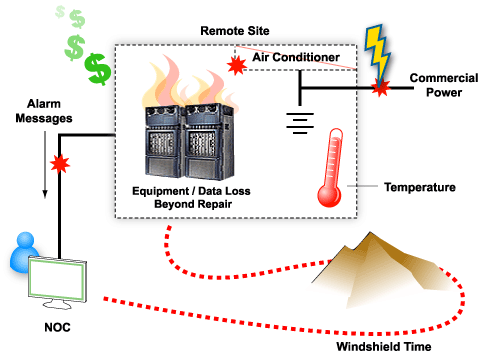Download our free Monitoring Fundamentals Tutorial.
An introduction to Monitoring Fundamentals strictly from the perspective of telecom network alarm management.
1-800-693-0351
Have a specific question? Ask our team of expert engineers and get a specific answer!
Sign up for the next DPS Factory Training!

Whether you're new to our equipment or you've used it for years, DPS factory training is the best way to get more from your monitoring.
Reserve Your Seat TodayThe primary damage caused by a power outage is obvious: if commercial power fails at your remote site, and you don't have a reliable backup power supply, the site will eventually go dark. Dark sites mean network downtime, lost revenue, and frustrated customers who will readily shift their business to an alternative provider.
But power outages create other damage that isn't so obvious. A complete power loss at a remote site can affect your equipment - and your business - in ways you don't know about.

Here are some of the top hidden damages caused by power outages. Consider these 5 good reasons why you need a bulletproof power monitoring and power backup plan:
You may have backup power for your revenue-generating equipment, but do you have backup power for your air conditioning?
A surprising number of telecoms forget about the need for air conditioning in a power outage. If commercial power at the remote site fails, backup power for telecommunications equipment automatically switches on, but the air conditioning has no power.
The valuable revenue-generating equipment keeps running - until it breaks down from heat damage. Heat damage from failed air conditioning is, in the long run, a greater expense than a site that simply fails from a power outage.
Most backup batteries are not designed to be completely drained of electricity. For the long-term working life of the battery, it must be connected to a constant source of recharging power, either commercial or from a working generator.
Batteries that are run all the way down can damaged permanently. Considering the expense of telecom-quality batteries, multiplied by the number of remote sites affected by the outage, this can become a noticeable business expense.
Anytime you have to put a highly paid technician in a truck and send him to a remote site you are losing money. If the problem could have been handled through monitoring and control relays, you're losing money completely unnecessarily.
Your power loss recovery plan must include an adequate source of backup power, and a means of switching to backup power automatically. You must also be able to monitor the status of your backup power supply, and regularly test whether battery levels are adequate and backup generators are functional.
(T/MonXM can help keep your power supply in good order. T/MonXM's derived alarms feature makes it easy to schedule generator self-tests that happen entirely in the background. You receive an alarm only if the generator does not automatically perform the test. For more information, see "Creating Derived Alarms for Events That Don't Happen.")
Maintaining your backup power supply will reduce the damage caused by power outages and the need for repairs, keeping your windshield time to the bare minimum.
Your remote monitoring equipment also needs a reliable source of backup power. A major service breakdown is no time to lose visibility of your remote sites.
If your remote monitoring equipment is offline during a power outage, you'll miss these critical alarms:
What all these hidden damages add up to is unnecessary costs. The net effect of a power outage is not on your equipment, or on your operations - the net effect is on your bottom line.
The financial effect of a power outage falls into four categories:
Unless you have an adequate backup plan, power outages mean increased costs and lost revenue. You owe it to your business to protect yourself with a proactive response to power outages.
UPS Battery Backup Monitoring Practices